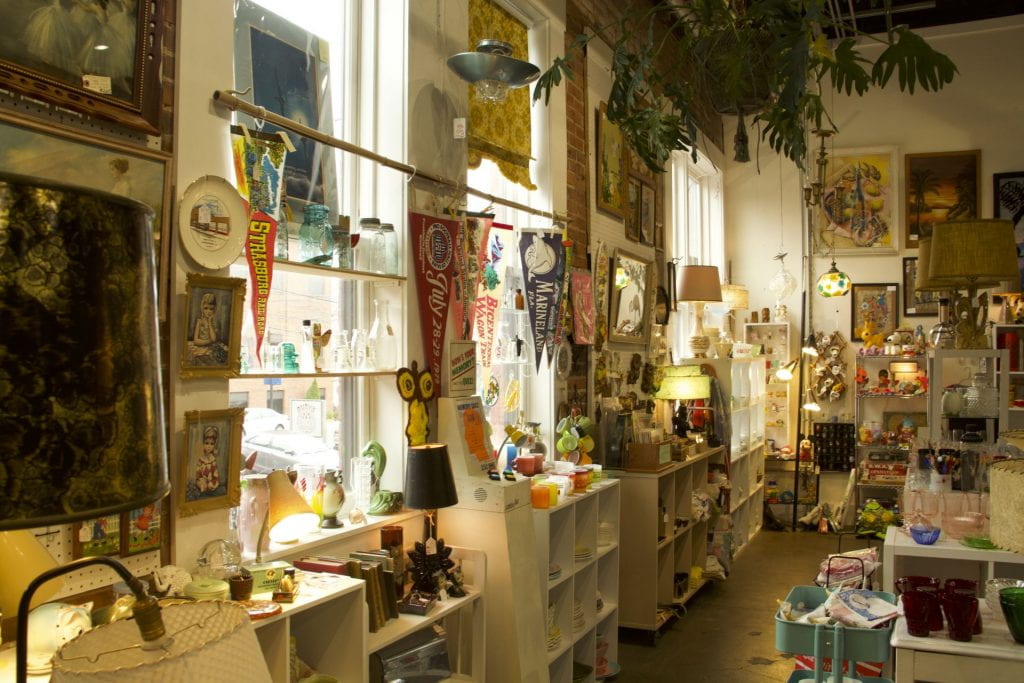By Meg Willcox

“The parties they attended, the music they saw, the dances and so on — I love that the clothing gets to continue its stories.”
Allie Motyka, the owner of Heartworn Vintage, and Mary Yoder-Anderson, owner of Dart Resale and Trade, believe every piece of clothing has a story.
Heartworn Vintage is located in Harrisonburg’s Agora Downtown Market. When customers visit the shop, they’re instantly met with bright and eccentric colors. The smell of the items is like being back at a grandparent’s house, giving a feeling of nostalgia. It carries trinkets, furniture, kitchenware and even old postcards and magazines from the 1950s.
The flashy and unique clothing is most notable. The dresses have sequins and puffy sleeves, and the ’80s high-waisted mom jeans seem to be the fastest-selling clothing item according to Motyka. Any purchase could be from halfway across the country, or just down the street. Heartworn Vintage sources its items from various places, so when multiple pieces come together it’s a true mix. A buyer may never know the story of the previous owner, but that’s the thrill.
“If we don’t know where the clothing came from, it certainly is fun to imagine the people who wore them before,” Motyka said. “The parties they attended, the music they saw, the dances and so on — I love that the clothing gets to continue its stories.”
But vintage clothing doesn’t just fit an aesthetic. It’s also sustainable. When consumers buy clothing from Heartworn Vintage, it means they’re buying items that aren’t using up resources or compromising future generations. According to an article from the National Library of Medicine, 60% of textile production is consumed by fashion, which has doubled in the last 15 years.
Eventually, the article states, 73% of clothing ends up in landfills. This means that fashion items are often just another throwaway item, not something seen as valuable or worth keeping. With thrifting and vintage shopping, that aspect of fashion is taken away. Now, fashion has a totally different meaning: It’s valued. If someone gets sick of a clothing item, they can just bring it to resellers. It’s all just an act of recycling. Dart Resale and Trade, which began as a pop up is now a full-blown reselling business on South Liberty Street. It’s all just an act of recycling.
On the other hand, Dart Resale and Trade began as a pop-up shop and became a full-blown business on South Liberty Street. The store is both charming and quaint with green walls and wooden features. It’s filled with carefully curated items like boots, Levi’s jeans and long, cozy sweaters. The shop accepts items on Tuesday’s, and Yoder-Anderson said she finds it to be her busiest day. Being a resale and trade shop, this means that individuals sell their items to the store, and they receive a profit based on how many items the shop choses to accept. They can also accept store credit and buy new clothes. Therefore, allowing the cycle of sustainability to continue.
“We get fun vintage jeans brought in by people that, you know, cleaned out their mom’s closet or their grandpa’s closet,” she said. “It’s really fun to just see all of the stuff that comes in, not knowing and looking through on a Tuesday seeing what we want.”
Much like Motyka, Yoder-Anderson loves the idea that clothing items can live multiple lives.
“I sometimes wonder about who owned the garment before and what its previous life was,” she said, wearing a pair of leather riding boots she got from a vintage store in Charlottesville, “and then it’s so fun when somebody comes in and finds the perfect item. It finds a perfect home.”
A specific piece could come from all the way across the country, but it ended up all the way in the Shenandoah Valley for someone else to enjoy. Yoder-Anderson had on a pair of riding boots that she found only an hour away in Charlottesville. Close or far, the items people can find are endless.
“It’s more fun,” Yoder-Anderson said. “You find more unique items, you find better items.”
It also makes it feel like fashion has no ties to culture, and instead, all ties to what’s “trendy.”
According to the article by the National Library of Medicine, “… a designer’s fashion calendar can consist of up to five collections per year, and in the mass-produced market, new stock is being produced every 2 weeks.” With vintage clothing, it’s the opposite. The clothing pieces have been around for a long time. “That’s another one of the awesome things about vintage,” Motyka said. “Rarely will you find the same item again.”
Whether you’re looking for a sparkly dress or an old pair of Levi’s jeans, these two stores have got you covered.